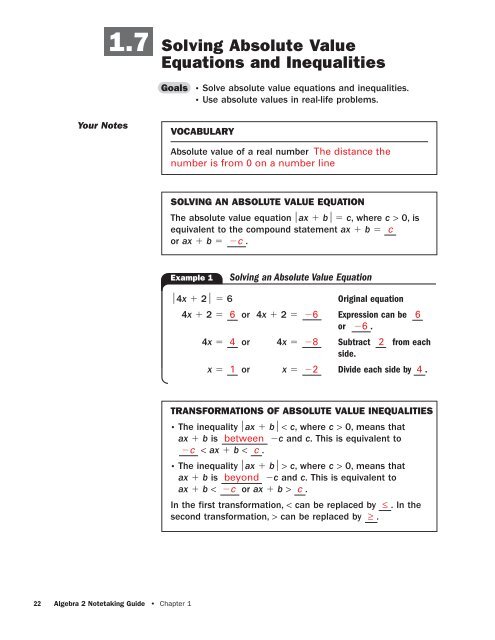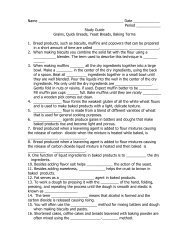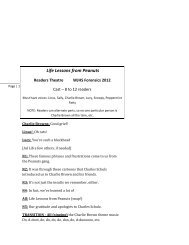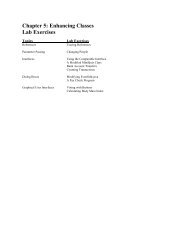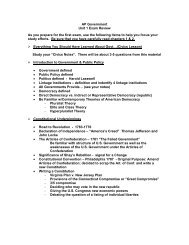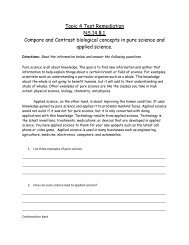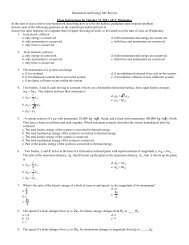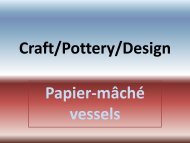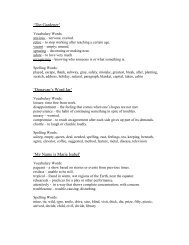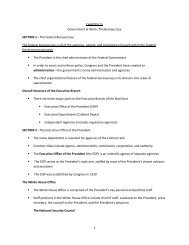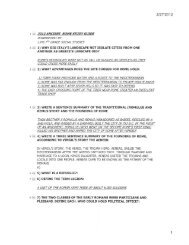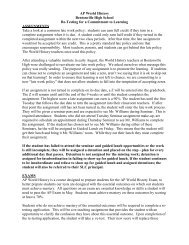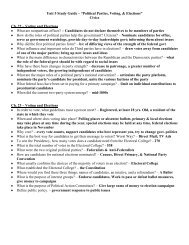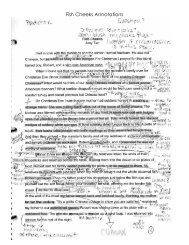Solving Absolute Value Equations and Inequalities
Solving Absolute Value Equations and Inequalities
Solving Absolute Value Equations and Inequalities
You also want an ePaper? Increase the reach of your titles
YUMPU automatically turns print PDFs into web optimized ePapers that Google loves.
1.7<br />
<strong>Solving</strong> <strong>Absolute</strong> <strong>Value</strong><br />
<strong>Equations</strong> <strong>and</strong> <strong>Inequalities</strong><br />
Goals p Solve absolute value equations <strong>and</strong> inequalities.<br />
p Use absolute values in real-life problems.<br />
Your Notes<br />
VOCABULARY<br />
<strong>Absolute</strong> value of a real number The distance the<br />
number is from 0 on a number line<br />
SOLVING AN ABSOLUTE VALUE EQUATION<br />
The absolute value equation ⏐ax b⏐ c, where c > 0, is<br />
equivalent to the compound statement ax b c<br />
or ax b c .<br />
Example 1<br />
<strong>Solving</strong> an <strong>Absolute</strong> <strong>Value</strong> Equation<br />
⏐4x 2⏐ 6<br />
Original equation<br />
4x 2 6 or 4x 2 6 Expression can be 6<br />
or 6 .<br />
4x 4 or 4x 8 Subtract 2 from each<br />
side.<br />
x 1 or x 2 Divide each side by 4 .<br />
TRANSFORMATIONS OF ABSOLUTE VALUE INEQUALITIES<br />
p The inequality ⏐ax b⏐< c, where c > 0, means that<br />
ax b is between c <strong>and</strong> c. This is equivalent to<br />
c < ax b < c .<br />
p The inequality ⏐ax b⏐> c, where c > 0, means that<br />
ax b is beyond c <strong>and</strong> c. This is equivalent to<br />
ax b < c or ax b > c .<br />
In the first transformation, < can be replaced by ≤ . In the<br />
second transformation, > can be replaced by ≥ .<br />
22 Algebra 2 Notetaking Guide • Chapter 1
Your Notes<br />
Example 2<br />
<strong>Solving</strong> an Inequality of the form⏐ax b⏐ < c<br />
Solve ⏐2x 3⏐ < 3.<br />
Solution<br />
⏐2x 3⏐ < 3 Write original inequality.<br />
3 < 2x 3 < 3 Write equivalent compound inequality.<br />
0 < 2x < 6 Add 3 to each expression.<br />
0 < x < 3 Divide each expression by 2 .<br />
The solutions are all real numbers greater than 0 <strong>and</strong> less<br />
than 3 . Check several solutions in the original inequality.<br />
Graph the solution below.<br />
2 1<br />
0 1 2 3 4 5<br />
Example 3<br />
<strong>Solving</strong> an Inequality of the form ⏐ax b⏐ ≥ c<br />
Solve ⏐2x 7⏐ ≥ 3.<br />
Solution<br />
This absolute value inequality is equivalent to 2x 7 ≤ 3<br />
or 2x 7 ≥ 3 .<br />
Solve first inequality<br />
Solve second inequality<br />
2x 7 ≤ 3 Write inequality. 2x 7 ≥ 3<br />
2x ≤ 10 Subtract 7 2x ≥ 4<br />
from each side.<br />
x ≤ 5 Divide each side x ≥ 2<br />
by 2 .<br />
The solutions are all real numbers less than or equal to 5<br />
or greater than or equal to 2 . Check several solutions in<br />
the original inequality. Graph the solution below.<br />
7<br />
6 5<br />
4 3 2 1<br />
0<br />
Lesson 1.7 • Algebra 2 Notetaking Guide 23
Your Notes<br />
Checkpoint Solve the equation or inequality.<br />
1.⏐5x 2⏐ 3 2.⏐3x 4⏐ < 2 3.⏐2x 3⏐ ≥ 5<br />
1 5 ,1 2 < x < 2 x ≤ 1 or<br />
3<br />
x ≥ 4<br />
Example 4<br />
Write a Model for Tolerance<br />
A dog food manufacturer has a tolerance of 0.25 pound per<br />
bag of dog food advertised as weighing 5 pounds. Write <strong>and</strong><br />
solve an absolute value inequality that describes the<br />
acceptable weights for “5 pound” bags.<br />
Verbal<br />
Model<br />
Actual weight<br />
<br />
Ideal weight<br />
≤<br />
Tolerance<br />
Labels<br />
Actual weight x<br />
(pounds)<br />
Ideal weight 5<br />
(pounds)<br />
Tolerance 0.25<br />
(pounds)<br />
Algebraic<br />
Model<br />
⏐x 5⏐ ≤ 0.25<br />
Write algebraic model.<br />
0.25 ≤ x 5 ≤ 0.25 Write equivalent<br />
compound inequality.<br />
4.75 ≤ x ≤ 5.25 Add 5 to each<br />
expression.<br />
The weights can range between 4.75 pounds <strong>and</strong><br />
5.25 pounds, inclusive.<br />
Checkpoint Complete the following exercise.<br />
Homework<br />
4. A toy manufacturer has a tolerance of 0.1 inch on a ball<br />
that is supposed to have a diameter of 1 inch. Write <strong>and</strong><br />
solve an inequality describing the acceptable diameters<br />
for a ball.<br />
⏐d 1⏐ ≤ 0.1, where d represents the actual<br />
diameter; 0.9 ≤ d ≤ 1.1<br />
24 Algebra 2 Notetaking Guide • Chapter 1


